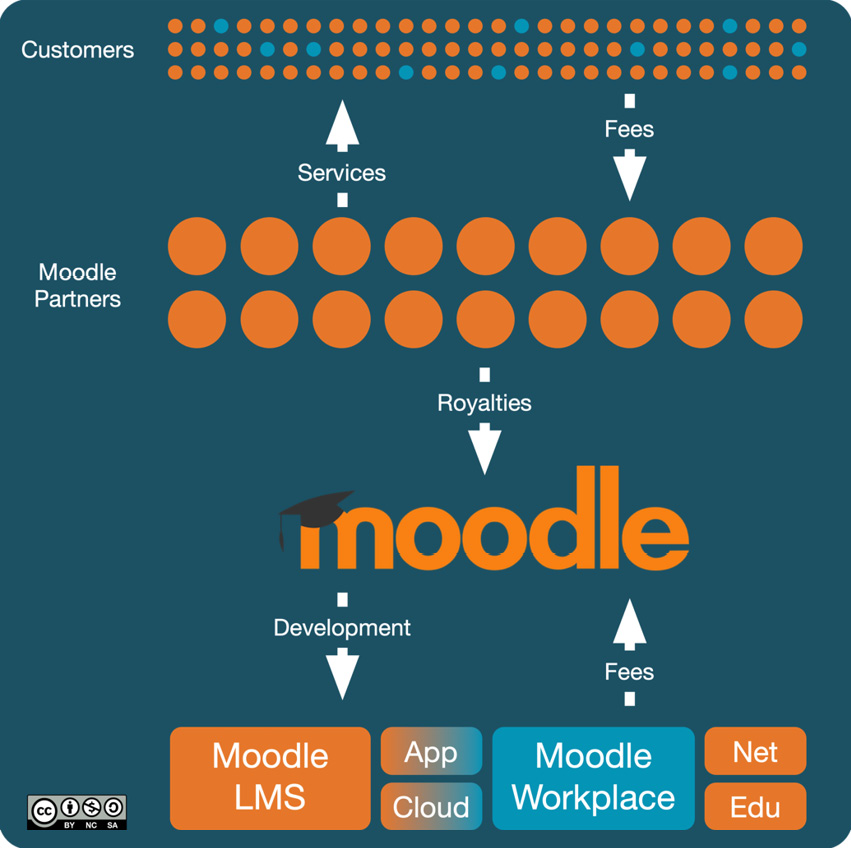Understanding the Moodle Workplace business model
60% of Moodle's revenue comes from the sectors that are targeted by Moodle Workplace, that is, commercial, not-for-profit, and government. Well-known examples of organizations that run Moodle include global enterprises such as Google, Cisco, Coca-Cola, Shell, Intel, and Bridgestone, but also large organizations such as the United Nations, which relies on Moodle as its LMS.
Moodle's main stream of revenue comes from Moodle Partners (Standard, Premium, and Integration), who pay royalties on all Moodle work. Customers who (hopefully) engage with a Moodle Partner pay fees for the services provided, such as consultancy, hosting, support, custom development, theme creation, and integration work. These high-level revenue streams are displayed in the following diagram, showing the overall Moodle business model:

Figure 1.2 – Moodle business model
Moodle HQ employs a global team of staff who develop and maintain a range of offerings, comprising the following six products (see moodle.com/products for more details):
- Moodle LMS: Standard Moodle plus Moodle plugins (as was covered earlier in the chapter).
- Moodle App: This includes the Moodle app, the Moodle Workplace app, and related chargeable branding services. We will deal with the Workplace app in Chapter 10, Mobile Learning.
- MoodleCloud: A Moodle Software-as-a-Service (SaaS) offering of Moodle LMS and Moodle Workplace (see further in this section for details). There is a free basic plan for small Moodle LMS projects; all other packages are paid-for offerings.
- Moodle Workplace: Well, you know what this is…
- MoodleNet: An open source social media platform for educators, integrated with Moodle and focused on collaboratively curating collections of open content.
- Moodle Education: The Moodle Educator Certification (MEC) program is a comprehensive teaching and learning curriculum designed to help you develop transferable knowledge and skills to be effective educators in today's growing digital workplace.
Both standard Moodle and Moodle Workplace are open source under the GNU Public License 3.0. However, unlike standard Moodle, which is available from the download section of moodle.org, Moodle Workplace is currently only available through Premium Moodle Partners (www.moodle.com/partners). Workplace can either be hosted in the data center facilities of a Moodle Partner or on-premises. The latter requires you to sign a three-way agreement between Moodle HQ, your Moodle (Premium) Partner, and your company. You need to agree to the Moodle Workplace License, which outlines your responsibilities as the customer.
The purpose of the aforementioned arrangement is to protect Moodle's significant investment in Moodle Workplace and to ensure that the Workplace source code is not distributed to any third parties.
The other option for utilizing Moodle Workplace in your business is via Workplace on MoodleCloud, a SaaS offering from Moodle HQ. It is a turnkey solution for sites of up to 1,000 users that includes a video conferencing tool (BigBlueButton) as well as access to content from GO1. However, Workplace on MoodleCloud does not allow you to install plugins or themes, and certain features and configuration settings cannot be changed. Depending on the chosen package, different Workplace features are limited, for instance, the number of tenants allowed or the number of custom reports that can be created. For more details and pricing, contact your Moodle Partner.
Now that you are familiar with Moodle's business model and its primary revenue streams, let's have a look at the Moodle Workplace versions, which differ slightly from the release schedule of standard Moodle.



